Tampons Were Packed With Their Strings Connecting Them, Like A Strip Of Sausages, So They Wouldn’t
Tampons were packed with their strings connecting them, like a strip of sausages, so they wouldn’t float away. Engineers asked Ride, “Is 100 the right number?” She would be in space for a week. “That would not be the right number,” she told them. At every turn, her difference was made clear to her. When it was announced Ride had been named to a space flight mission, her shuttle commander, Bob Crippen, who became a lifelong friend and colleague, introduced her as “undoubtedly the prettiest member of the crew.” At another press event, a reporter asked Ride how she would react to a problem on the shuttle: “Do you weep?”
Astronaut Sally Ride and the Burden of Being “The First” (via dinosaurparty)
More Posts from Womeninspaceexploration and Others
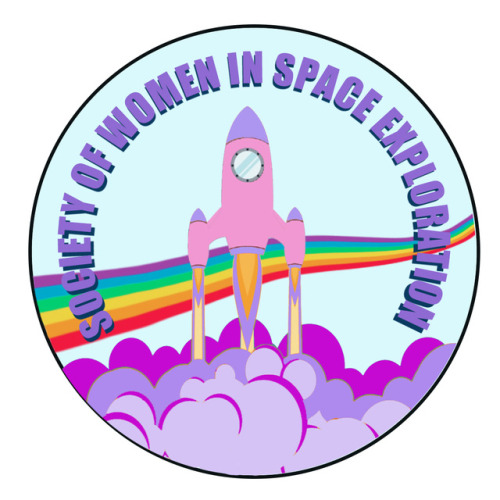
Society of Women in Space Exploration
https://www.swise.org
Interview with Bianca Vasquez - Founder
1. Can you share a bit about yourself and what you do?
I am a mechanical engineering student at Santa Barbara City College. I will be transferring to university within the next year or two. When I'm not doing school related work, I run the Society of Women in Space Exploration, an organization that provides a platform for young girls in college to learn more about themselves as young professionals and future leaders and allow for them to take on a leadership role in their community.
2. What made you interested in space/space exploration?
Like most people interested in space, the curiosity. There are so many questions that come with space that we have about the past, the present, and the future of our universe. What really got me excited about pursuing it, was learning about many of the incredible women that contribute to the discoveries and innovation and how although they are a minority in the field, they own it and continue to thrive and be examples for other young girls that wish to follow in their footsteps! Representation matters and having role models can really affect the way you feel about your goals.
3. What are some challenges you’ve had to face within this field?
I've dealt a lot with imposter syndrome. Space exploration, and STEM in general, is highly competitive. When you do not grow up with the resources and the representation, you start to doubt your abilities. For a few years in college I was in and out of pursuing STEM because I didn't know if I belonged. The truth is, anyone that wants to do this belongs. We need to give more girls and minorities the confidence to follow their dreams, and when more of us do, we open doors for others after us. We wonder why so many women drop out of STEM in general.. it's not because they don't like it, it's because things can be hard when you feel isolated and underrepresented. I've found that I do better when I am around people that are inclusive, welcoming, encouraging, and resemble me somehow. Whether that's other Latinos, other women, or just like minded people.
4. What do you hope to achieve with your society?
I truly hope Society of Women in Space Exploration (SWISE) encourages other girls to pursue their space dreams. I want SWISE to bring girls with similar ambitions together and develop lifelong friendships and genuine bonds + support systems. We do better when we uplift each other and support each other. I hope SWISE positively affects these girls and changes the way they feel about being a minority in the industry; by seeing it as a strength rather than a setback.
5. Some of your inspirations and why?
I do not have a specific dream job (yet) because there are so many things out there, and I am constantly growing and learning more about myself, but I do know that I want to be happy with what I end up doing, and work with positive, innovative people that want to change the world for the better. To work on things that will be sent to space to further our knowledge on the universe would be awesome!!
6. Anything else you’d like to share? (personal experiences/ advice for other women)
Diversity is so so so important. When we have a diverse group of people working to fix a problem, we hear things from different perspectives. We operate with so much context- our backgrounds, our experiences, our way of doing things. Diversity in thought = diversity in solutions. That goes for any field. Diversity in space exploration is extremely key because space is the biggest thing out there. It's not man made, and we can't control it. We can only understand it, and in order to do so, we need all the greatest, most innovative and curious minds we can get!


Astronaut Davis At Work
Description: Astronaut N. Jan Davis, payload commander, is pictured at the work station for the Remote Manipulator System (RMS) on the aft flight deck of the Space Shuttle Discovery during mission STS-85. Davis controlled and oversaw operations with the Cryogenic Infrared Spectrometers and Telescopes for the Atmosphere-Shuttle Pallet Satellite-2 (CRISTA-SPAS-2) during the 12-day mission in Earth-orbit.
Image # STS085-312-027
Date: August 19, 1997
The Shocking Behavior of a Speedy Star
Roguish runaway stars can have a big impact on their surroundings as they plunge through the Milky Way galaxy. Their high-speed encounters shock the galaxy, creating arcs, as seen in this newly released image from NASA’s Spitzer Space Telescope.
In this case, the speedster star is known as Kappa Cassiopeiae, or HD 2905 to astronomers. It is a massive, hot supergiant. But what really makes the star stand out in this image is the surrounding, streaky red glow of material in its path. Such structures are called bow shocks, and they can often be seen in front of the fastest, most massive stars in the galaxy.
Bow shocks form where the magnetic fields and wind of particles flowing off a star collide with the diffuse, and usually invisible, gas and dust that fill the space between stars. How these shocks light up tells astronomers about the conditions around the star and in space. Slow-moving stars like our sun have bow shocks that are nearly invisible at all wavelengths of light, but fast stars like Kappa Cassiopeiae create shocks that can be seen by Spitzer’s infrared detectors.
Incredibly, this shock is created about 4 light-years ahead of Kappa Cassiopeiae, showing what a sizable impact this star has on its surroundings. (This is about the same distance that we are from Proxima Centauri, the nearest star beyond the sun.)
The Kappa Cassiopeiae bow shock shows up as a vividly red color. The faint green features in this image result from carbon molecules, called polycyclic aromatic hydrocarbons, in dust clouds along the line of sight that are illuminated by starlight.
Delicate red filaments run through this infrared nebula, crossing the bow shock. Some astronomers have suggested these filaments may be tracing out features of the magnetic field that runs throughout our galaxy. Since magnetic fields are completely invisible themselves, we rely on chance encounters like this to reveal a little of their structure as they interact with the surrounding dust and gas.
Kappa Cassiopeiae is visible to the naked eye in the Cassiopeia constellation (but its bow shock only shows up in infrared light.)
For this Spitzer image, infrared light at wavelengths of 3.6 and 4.5 microns is rendered in blue, 8.0 microns in green, and 24 microns in red.
Image#: f501dee2-213b-4a38-b05f-b8361ae9c71b
Date: February 20, 2014


NASA’s Hidden Figure
NASA research mathematician Katherine Johnson is photographed at work at NASA Langley Research Center in 1980.
Johnson began her career in 1953 at the National Advisory Committee for Aeronautics (NACA), the agency that preceded NASA, one of a number of African-American women hired to work as "computers" in what was then their Guidance and Navigation Department, just as the NACA was beginning its work on space. Johnson became known for her training in geometry, her leadership, and her inquisitive nature; she was the only woman at the time to be pulled from the computing pool to work with engineers on other programs. Katherine Johnson spent more than three decades as a mathematician at NASA and the NACA.
Johnson worked at Langley from 1953 until her retirement in 1986, making critical technical contributions which included calculating the trajectory of the 1961 flight of Alan Shepard, the first American in space. "The early trajectory was a parabola, and it was easy to predict where it would be at any point," Johnson said. "Early on, when they said they wanted the capsule to come down at a certain place, they were trying to compute when it should start. I said, 'Let me do it. You tell me when you want it and where you want it to land, and I'll do it backwards and tell you when to take off.' That was my forte."
Johnson is also known for verifying the calculations made by electronic computers of John Glenn’s 1962 launch to orbit and the 1969 Apollo 11 trajectory to the moon. She also worked on the space shuttle program and the Earth Resources Satellite and encouraged students to pursue careers in science and technology. She was awarded the Presidential Medal of Freedom, the nation's highest civilian honor, by President Barack Obama on Nov. 24, 2015.
Image Credit: NASA
Read more about the hidden figures of NASA here
Hubble’s Hidden Galaxy
C 342 is a challenging cosmic target. Although it is bright, the galaxy sits near the equator of the Milky Way’s galactic disk, where the sky is thick with glowing cosmic gas, bright stars, and dark, obscuring dust. In order for astronomers to see the intricate spiral structure of IC 342, they must gaze through a large amount of material contained within our own galaxy — no easy feat! As a result IC 342 is relatively difficult to spot and image, giving rise to its intriguing nickname: the “Hidden Galaxy.”
Located very close (in astronomical terms) to the Milky Way, this sweeping spiral galaxy would be among the brightest in the sky were it not for its dust-obscured location. The galaxy is very active, as indicated by the range of colors visible in this NASA/ESA Hubble Space Telescope image, depicting the very central region of the galaxy. A beautiful mixture of hot, blue star-forming regions, redder, cooler regions of gas, and dark lanes of opaque dust can be seen, all swirling together around a bright core. In 2003, astronomers confirmed this core to be a specific type of central region known as an HII nucleus — a name that indicates the presence of ionized hydrogen — that is likely to be creating many hot new stars.
Image credit: ESA/Hubble & NASA
Text credit: European Space Agency

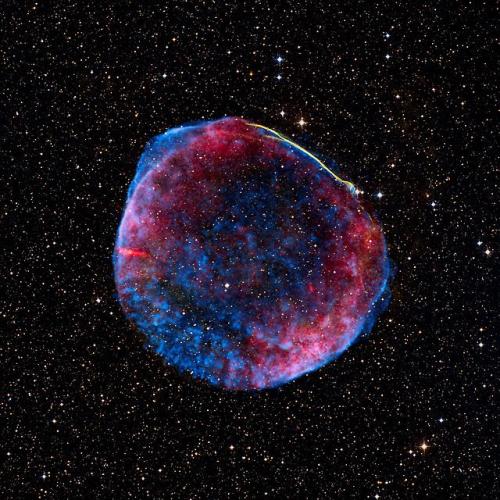
Sally K. Ride
Title: Sally K. Ride
Catalog #: WOF_00203
Additional Information: Astronaut
Item Location: Women of Flight Box 3
Collection: Women of Flight Special Collection
Tags: Women of Flight Photo, Sally K. Ride
Repository: San Diego Air and Space Museum Archive
Hubble Sees Stars and a Stripe in Celestial Fireworks
Creator: NASA Goddard
Date Created: 12/8/2017
NASA ID: GSFC_20171208_Archive_e002166
Release date: July 1, 2008 This image is a composite of visible (or optical), radio, and X-ray data of the full shell of the supernova remnant from SN 1006. The radio data show much of the extent that the X-ray image shows. In contrast, only a small linear filament in the northwest corner of the shell is visible in the optical data. The object has an angular size of roughly 30 arcminutes (0.5 degree, or about the size of the full moon), and a physical size of 60 light-years (18 parsecs) based on its distance of nearly 7,000 light-years. The small green box along the bright filament at the top of the image corresponds to the dimensions of the Hubble release image. The optical data was obtained at the University of Michigan's 0.9-meter Curtis Schmidt telescope at the National Science Foundation's Cerro Tololo Inter-American Observatory (CTIO) near La Serena, Chile. H-alpha, continuum-subtracted data were provided by F. Winkler (Middlebury COllege) et al. The X-ray data were acquired from the Chandra X-ray Observatory's AXAF CCD Imaging Spectrometer (ACIS) at 0.5-3keV, and were provided by J. Hughes (Rutgers University) et al. The radio data, supplied by K. Dyer (NRAO, Socorro) et al., were a composite from the National Radio Astronomy Observatory's Very Large Array (NRAO/VLA) in Socorro, New Mexico, along with the Green Bank Telescope (GBT) in Green Bank, West Virginia. Data of the supernova remnant were blended on a visible-light stellar background created using the Digitized Sky Survey's Anglo-Australian Observatory (AAO2) blue and red plates. Photo Credit: NASA, ESA, and Z. Levay (STScI) Science Credit: Radio: NRAO/AUI/NSF GBT+VLA 1.4 GHz mosaic (Dyer, Maddalena and Cornwell, NRAO); X-ray: NASA/CXC/Rutgers/G. Cassam-Chenai and J. Hughes et al.; Optical: F.Winkler/Middlebury College and NOAO/AURA/NSF; and DSS
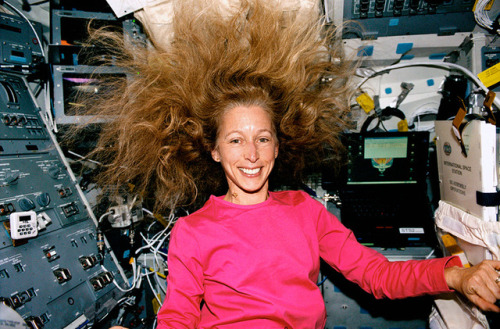
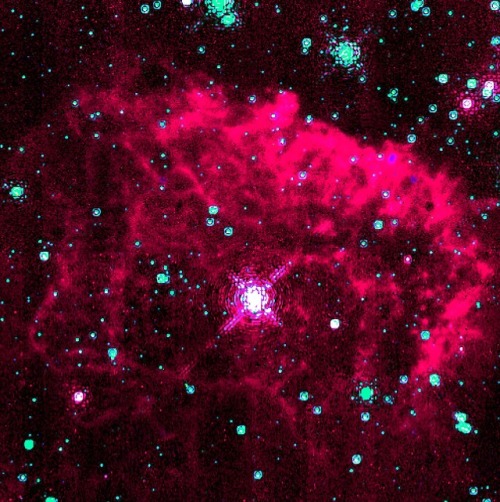
Marsha Ivins on board the space shuttle Atlantis in 2001
Mission Specialist (MS) Marsha Ivins, her hair loose and free floating in microgravity, smiles for the camera on Atlantis' Aft Flight Deck (AFD). Photo was taken during Mission STS-98 International Space Station (ISS) Flight 5A.
Identifier sts098-348-015
From here
The Pistol Nebula
Want to see the brightest star in the sky? It would seem that on October 8, 1997, the Hubble Space Telescope found the most luminous star in the midst of a bright nebula. The star in question emits far more power than our Sun does – and its diameter alone encompasses the Earth’s entire orbit around the Sun. Though it certainly doesn’t seem quite as large in the beautiful, violet-hued image.


Materials Science Experiments Conducted at MSFC
In another first for NASA, an all-female crew of scientific experimenters began a five-day exercise on December 16, 1974, to test the feasibility of experiments that were later tested on the Space Shuttle/Spacelab missions. The experimenters, Dr. Mary H. Johnston (seated, left), Ann F. Whitaker and Carolyn S. Griner (standing, left to right), and the crew chief, Doris Chandler, spent spend eight hours each day of the mission in the Marshall Space Flight Centers General Purpose Laboratory (GPL). They conducted 11 selected experiments in materials science to determine their practical application for Spacelab missions and to identify integration and operational problems that might occur on actual missions.
Image # :565782
Date: November 13, 1974
N81 in the Small Magellanic Cloud
A NASA Hubble Space Telescope "family portrait" of young, ultra-bright stars nested in their embryonic cloud of glowing gases. The celestial maternity ward, called N81, is located 200,000 light-years away in the Small Magellanic Cloud (SMC), a small irregular satellite galaxy of our Milky Way. Hubble's exquisite resolution allows astronomers to pinpoint 50 separate stars tightly packed in the nebula's core within a 10 light- year diameter - slightly more than twice the distance between earth and the nearest star to our sun. The closest pair of stars is only 1/3 of a light-year apart (0.3 arcseconds in the sky). This furious rate of mass loss from these super-hot stars is evident in the Hubble picture that reveals dramatic shapes sculpted in the nebula's wall of glowing gases by violent stellar winds and shock waves. A pair of bright stars in the center of the nebula is pouring out most of the ultraviolet radiation to make the nebula glow. Just above them, a small dark knot is all that is left of the cold cloud of molecular hydrogen and dust the stars were born from. Dark absorption lanes of residual dust trisect the nebula. The nebula offers a unique opportunity for a close-up glimpse at the firestorm' accompanying the birth of extremely massive stars, each blazing with the brilliance of 300,000 of our suns. Such galactic fireworks were much more common billions of years ago in the early universe, when most star formation took place. The "natural- color" view was assembled from separate images taken with the Wide Field and Planetary Camera 2, in ultraviolet light and two narrow emission lines of ionized Hydrogen (H-alpha, H-beta).
Image # : PR98-25
Date: September 24, 1997
What I learned when I was in space was that the planets will be here, but we might not. We have a completely misguided sense of importance.
Mae Jemison
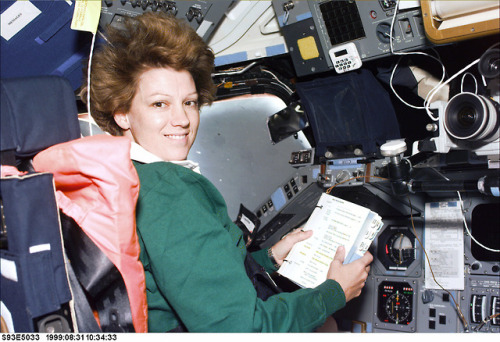
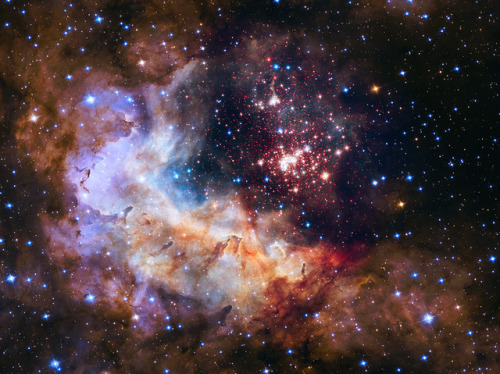
Columbia Commander Eileen Collins
(July 24, 1999) Commander Eileen Collins consults a checklist while seated at the flight deck Commander's station in the Shuttle Columbia during STS-93.
Image # : S93E5033
Hubble Space Telescope Celebrates 25 Years of Unveiling the Universe
The brilliant tapestry of young stars flaring to life resemble a glittering fireworks display in the 25th anniversary NASA Hubble Space Telescope image to commemorate a quarter century of exploring the solar system and beyond since its launch on April 24, 1990.
The sparkling centerpiece of Hubble's silver anniversary fireworks is a giant cluster of about 3,000 stars called Westerlund 2, named for Swedish astronomer Bengt Westerlund, who discovered the grouping in the 1960s. The cluster resides in a raucous stellar breeding ground known as Gum 29, located 20,000 light-years away from Earth in the constellation Carina.
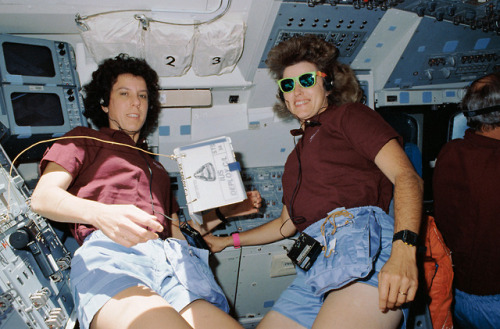
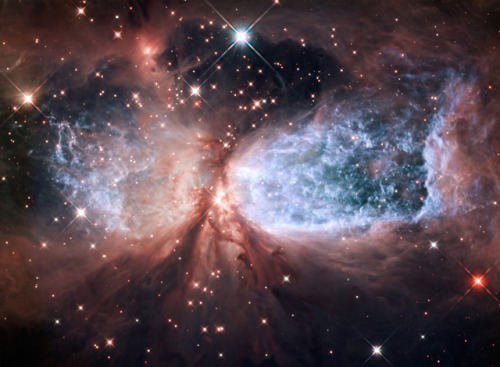
STS-34 crew members during Galileo pre-deployment exercises on flight deck
NASA ID: s34-09-007
Date Created: 1989-10-18
STS034-09-007 (23 Oct. 1989) --- Having been in space only a few hours, three of the STS-34 astronaut crew prepare for pre-deployment exercises involving one of the most prominent "passengers" of the flight -- the Galileo payload which was lying in Atlantis', Orbiter Vehicle (OV) 104's, payload bay (PLB). Pictured, left to right, are astronauts Ellen S. Baker and Shannon W. Lucid, both mission specialists; along with Donald E. Williams, commander, who guided OV-104's course during the exercise. Baker and Lucid communicated with ground controllers while juggling other Galileo-related chores. Both Baker and Lucid are equipped with SONY Walkmans and are wearing headsets. Lucid wears a pair of sunglasses with brightly colored frames. A tethered inertial upper stage (IUS) deploy checklist (C/L) floats between the two and a spot meter is Velcroed to an on orbit station control panel.
Hubble Serves Up a Holiday Snow Angel
NASA ID: GSFC_20171208_Archive_e001800
Date Created: 12/8/2017
The bipolar star-forming region, called Sharpless 2-106, looks like a soaring, celestial snow angel. The outstretched “wings” of the nebula record the contrasting imprint of heat and motion against the backdrop of a colder medium. Twin lobes of super-hot gas, glowing blue in this image, stretch outward from the central star. This hot gas creates the “wings” of our angel. A ring of dust and gas orbiting the star acts like a belt, cinching the expanding nebula into an “hourglass” shape. To read more about this image go to: <a href="http://www.nasa.gov/mission_pages/hubble/science/snow-angel.html" rel="nofollow">www.nasa.gov/mission_pages/hubble/science/snow-angel.html</a> Credit: NASA, ESA, and the Hubble Heritage Team (STScI/AURA) <b><a href="http://www.nasa.gov/audience/formedia/features/MP_Photo_Guidelines.html" rel="nofollow">NASA image use policy.</a></b> <b><a href="http://www.nasa.gov/centers/goddard/home/index.html" rel="nofollow">NASA Goddard Space Flight Center</a></b> enables NASA’s mission through four scientific endeavors: Earth Science, Heliophysics, Solar System Exploration, and Astrophysics. Goddard plays a leading role in NASA’s accomplishments by contributing compelling scientific knowledge to advance the Agency’s mission.

-
 goldencloud liked this · 1 year ago
goldencloud liked this · 1 year ago -
 insanecorgi liked this · 2 years ago
insanecorgi liked this · 2 years ago -
 whomst-the-heck-am-i liked this · 2 years ago
whomst-the-heck-am-i liked this · 2 years ago -
 cheshire-cat-in-the-rain reblogged this · 2 years ago
cheshire-cat-in-the-rain reblogged this · 2 years ago -
 summerwild reblogged this · 3 years ago
summerwild reblogged this · 3 years ago -
 faerielightning reblogged this · 3 years ago
faerielightning reblogged this · 3 years ago -
 faerielightning liked this · 3 years ago
faerielightning liked this · 3 years ago -
 wishingforbooks reblogged this · 3 years ago
wishingforbooks reblogged this · 3 years ago -
 wishingforbooks liked this · 3 years ago
wishingforbooks liked this · 3 years ago -
 aw16st reblogged this · 4 years ago
aw16st reblogged this · 4 years ago -
 belosers reblogged this · 4 years ago
belosers reblogged this · 4 years ago -
 ithinkimgoingbananas reblogged this · 4 years ago
ithinkimgoingbananas reblogged this · 4 years ago -
 furiosaofscythia reblogged this · 4 years ago
furiosaofscythia reblogged this · 4 years ago -
 summerfevers liked this · 5 years ago
summerfevers liked this · 5 years ago -
 letslandshark reblogged this · 5 years ago
letslandshark reblogged this · 5 years ago -
 letslandshark liked this · 5 years ago
letslandshark liked this · 5 years ago -
 iwillspitinyourmouth liked this · 5 years ago
iwillspitinyourmouth liked this · 5 years ago -
 huntergrlx reblogged this · 5 years ago
huntergrlx reblogged this · 5 years ago -
 huntergrlx liked this · 5 years ago
huntergrlx liked this · 5 years ago -
 eclecticphilosopherflower reblogged this · 5 years ago
eclecticphilosopherflower reblogged this · 5 years ago -
 whynotputfeelingsintoactions reblogged this · 5 years ago
whynotputfeelingsintoactions reblogged this · 5 years ago -
 nicksuckseggs liked this · 5 years ago
nicksuckseggs liked this · 5 years ago -
 gay-drian reblogged this · 5 years ago
gay-drian reblogged this · 5 years ago -
 figurante-no1 reblogged this · 5 years ago
figurante-no1 reblogged this · 5 years ago -
 halfblood-chaser reblogged this · 5 years ago
halfblood-chaser reblogged this · 5 years ago -
 halfblood-chaser liked this · 5 years ago
halfblood-chaser liked this · 5 years ago -
 merman-witha-merplan reblogged this · 5 years ago
merman-witha-merplan reblogged this · 5 years ago -
 blindedbybooks reblogged this · 5 years ago
blindedbybooks reblogged this · 5 years ago -
 choimin-ho liked this · 5 years ago
choimin-ho liked this · 5 years ago -
 kill-urine-bubbles reblogged this · 5 years ago
kill-urine-bubbles reblogged this · 5 years ago -
 megacurlyhairclub reblogged this · 6 years ago
megacurlyhairclub reblogged this · 6 years ago -
 from-ashes-i-rise reblogged this · 6 years ago
from-ashes-i-rise reblogged this · 6 years ago -
 chantrymouse liked this · 6 years ago
chantrymouse liked this · 6 years ago -
 blissandbookstores liked this · 6 years ago
blissandbookstores liked this · 6 years ago -
 the-loquacious-lark reblogged this · 6 years ago
the-loquacious-lark reblogged this · 6 years ago -
 womeninspaceexploration reblogged this · 6 years ago
womeninspaceexploration reblogged this · 6 years ago -
 rosekitty414 reblogged this · 6 years ago
rosekitty414 reblogged this · 6 years ago -
 rosekitty414 liked this · 6 years ago
rosekitty414 liked this · 6 years ago -
 gypsyparker reblogged this · 6 years ago
gypsyparker reblogged this · 6 years ago -
 gypsyparker liked this · 6 years ago
gypsyparker liked this · 6 years ago
